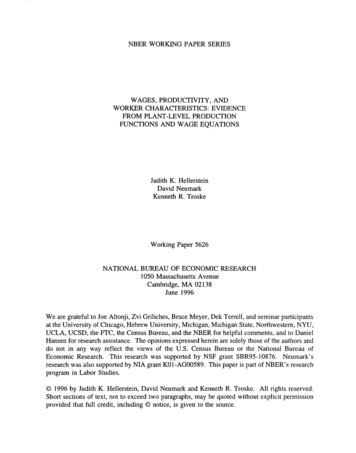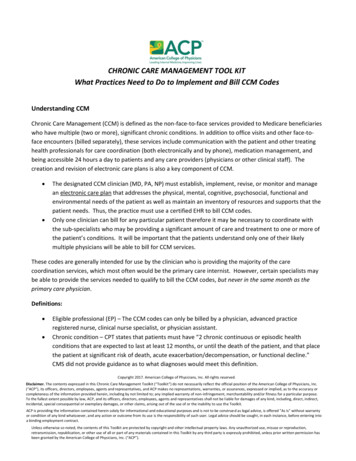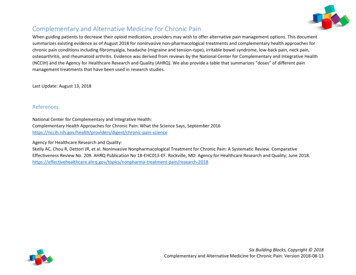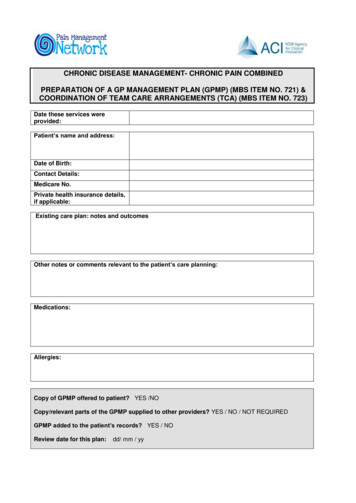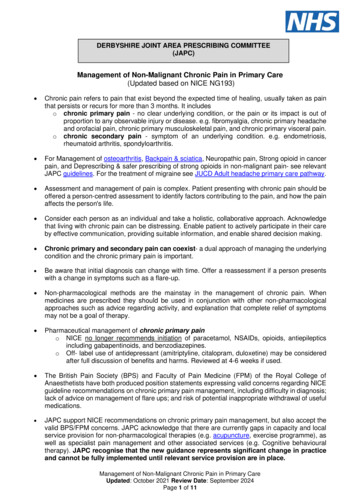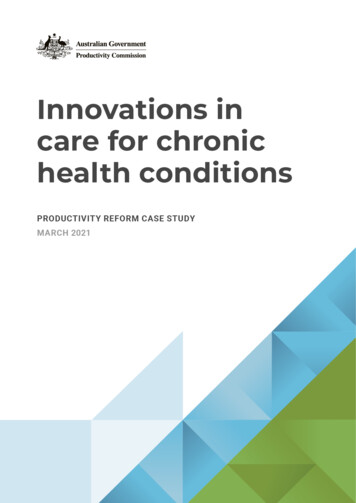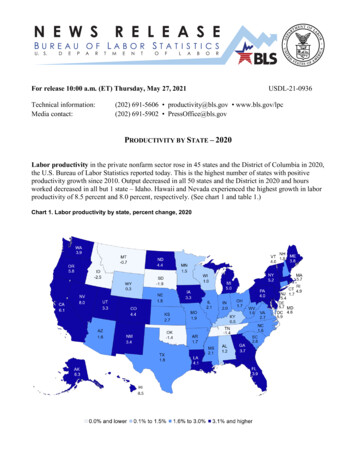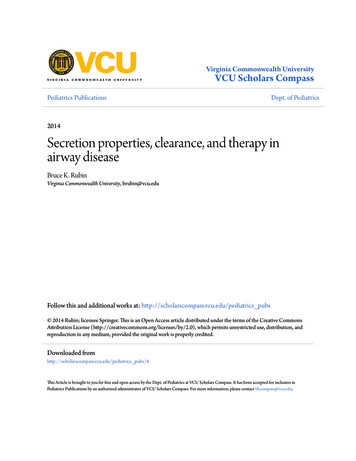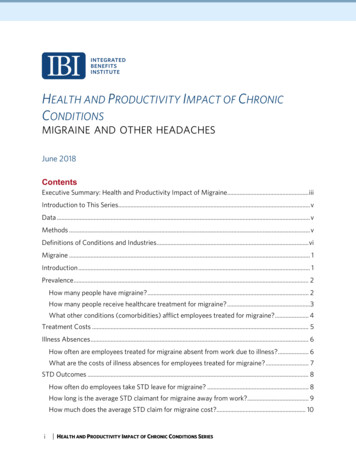
Transcription
HEALTH AND PRODUCTIVITY IMPACT OF CHRONICCONDITIONSMIGRAINE AND OTHER HEADACHESJune 2018ContentsExecutive Summary: Health and Productivity Impact of Migraine. iiiIntroduction to This Series. vData . vMethods . vDefinitions of Conditions and Industries. viMigraine . 1Introduction . 1Prevalence . 2How many people have migraine? . 2How many people receive healthcare treatment for migraine? .3What other conditions (comorbidities) afflict employees treated for migraine? . 4Treatment Costs . 5Illness Absences . 6How often are employees treated for migraine absent from work due to illness? . 6What are the costs of illness absences for employees treated for migraine? . 7STD Outcomes . 8How often do employees take STD leave for migraine? . 8How long is the average STD claimant for migraine away from work?. 9How much does the average STD claim for migraine cost?. 10i HEALTH AND PRODUCTIVITY IMPACT OF CHRONIC CONDITIONS SERIES
LTD Outcomes. 11How many employees are on LTD leave for migraine over a given year? . 11How many LTD claims for migraine close within two years? . 12How much of each work year is lost by the average LTD claimant for migraine? . 13How much does the average LTD claim for migraine cost each year?.14Total Costs of Migraine in a Workforce . 15What are the estimated annual costs associated with migraine in a 1,000-personworkforce? . 15Evidence for Workplace Interventions . 16Additional Information about Migraine. 17Appendix . 18Supplemental data . 18Regression models . 18About IBI. 20ii HEALTH AND PRODUCTIVITY IMPACT OF CHRONIC CONDITIONS SERIES
Executive Summary: Health and Productivity Impact of Migraine 14% of employed U.S. adults reported having severe headaches or migraine in the prior three months.Women were more than twice as likely as men to report severe headaches or migraine (20% compared to9%). The rate of treatments for migraine was about one fifth of the reported prevalence—3% of employed U.S.adults had treatments for migraine (ICD-9 diagnosis codes 364.xx and 784.0). Women were almost fivetimes as likely as men to have had treatments for migraine (5.2% compared to 1.1%) One in three employees with migraine also has obesity. Mood disorders, back pain, anxiety disorders, andhypertensive disease each afflict about one in five employees with migraine. Excess medical and pharmacy treatment costs for employees with migraine averaged almost 2,000 peryear. Employees with migraine had an average of 2.2 excess sick days per year, at a cost of almost 600 in wagesand benefits. Each year, employers’ short-term disability (STD) insurance policies experience an average of 2.4 newclaims for migraine per 10,000 covered lives. STD claims for migraine incur an average of 38 lost workdays,at an average cost of about 7,700 in wage replacements and paid employee benefits. This represents about 10,400 in lost economic output. Each year, employers’ long-term disability (LTD) insurance policies manage an average of 1.0 active claimsfor migraine per 10,000 covered lives. Claims that carried over from previous years outnumber new claimsby 1.5 to 1. Of LTD claims for migraine, 37% remain open two years after they begin. LTD claims for migraineincur an average of 179 lost workdays per year that they remain open, at an average cost of about 37,000in wage replacements and paid employee benefits per year. Overall, for every 1,000 U.S. employees, migraine in the workforce costs about 84,000 in excesshealthcare treatments and lost work time. This does not include the value of returns to lost labor inputs,early exits from the labor force, excess turnover costs and presenteeism (underperformance on the job dueto migraine). Considerable cost differences are observed across industries, ranging from about 65,000 per 1,000employees in the transportation and utilities industry to about 180,000 per 1,000 employees in the financeindustry.iii HEALTH AND PRODUCTIVITY IMPACT OF CHRONIC CONDITIONS SERIES
iv HEALTH AND PRODUCTIVITY IMPACT OF CHRONIC CONDITIONS SERIES
Introduction to This SeriesHelping employees manage chronic illnesses remains one of the most viable strategies for reducing employers’healthcare and disability costs. IBI’s Health and Productivity Impact of Chronic Conditions series uses high-qualitydata to model healthcare, illness absence (i.e., sick days) and disability costs for populations of employees acrossdifferent industries. The results provide a scalable cost benchmark that employers and their supplier partners canuse to assess the potential savings from reductions in the prevalence of a condition, costs of treatments, andillness-related absences and disability leaves.DataThe series uses data primarily from three sources.Data from the Agency for Healthcare Research and Quality’s (AHRQ’s) Medical Expenditure Panel Survey (MEPS)1are used for healthcare costs and illness absences. MEPS collects annual, nationally representative informationabout health status, care utilization and treatment costs from components: (1) a survey of U.S. households, withinformation supplemented by data from household members’ medical providers (the household component);and (2) a separate survey of employers about their employment-based health insurance plans (the insurancecomponent). This report uses person-level data from the 2011–2015 household component files for informationabout health conditions, healthcare costs, illness absences, and demographic and occupational/industrialcharacteristics.MEPS data can identify persons with a condition for which they sought treatment. For symptomatic conditionssuch as migraine that may be underdiagnosed, this may lead to underreporting of the actual prevalence in apopulation. For this reason, data from the Centers for Disease Control and Prevention's (CDC) National Health2Interview Survey are used to report the proportion of persons who respond yes to the question, "During the pastthree months, did you have . severe headache or migraine?" This report uses data from 2011-2016 surveys.3Data from IBI’s Health and Productivity Benchmarking System (referred to simply as Benchmarking) are used forshort-term disability (STD) and long-term disability (LTD) outcomes. Each year, Benchmarking collects millionsof STD and LTD claims from the books of business of 14 of the largest U.S. disability insurance carriers and thirdparty administrators. This report uses claims data for calendar years 2011–2016 for information on diagnoses,claims rates, durations and industry.This report also incorporates information about wages and benefits from the U.S. Bureau of Labor Statistics (BLS)and healthcare cost growth estimates from the Centers for Medicare & Medicaid Services. Detailed informationabout the data and analytic methods is included in the appendix.MethodsAttributing healthcare costs and illness absences to specific conditions poses well-known challenges. This isprimarily due to the presence of comorbidities that can impact the severity of illness symptoms and the efficacy1AHRQ. Medical Expenditure Panel Survey. https://meps.ahrq.gov/mepsweb/about meps/survey back.jsp2Lynn A. Blewett, Julia A. Rivera Drew, Risa Griffin, Miram L. King, and Kari C. W. Williams. IPUMS HealthSurveys: National Health Interview Survey, Version 6.2. Minneapolis: University of Minnesota, 2016.http://doi.org/10.18128/D070.V6.2 http://www.nhis.ipums.org3Integrated Benefits Institute. Health and Productivity Benchmarking. https://ibiweb.org/benchmarkingv HEALTH AND PRODUCTIVITY IMPACT OF CHRONIC CONDITIONS SERIES
4or intensity of care management. For this reason, we control for the presence of other chronic conditions foranalyses of healthcare costs and illness absences in a way that permits us to compare the excess burdens forpersons with a specific condition, over and above the burdens associated with their other conditions. See theappendix for details on the models. Lost work time and costs associated with disability claims are morestraightforward—no detail on comorbidities is provided, so only average outcomes are reported. All outcomesare reported on an annual basis.Definitions of Conditions and IndustriesCONDITIONS5Conditions are defined using the International Classification of Diseases, 9th revision (ICD-9), based on the threedigit diagnosis categories available in the MEPS data. Benchmarking data contain full ICD-9 diagnosis information,which is truncated to conform to the MEPS three-digit reporting. Individuals in the MEPS data are determined tohave a condition based on records in the medical conditions files of the household component. Benchmarkingdisability claims record only the primary claim diagnosis.INDUSTRIESMEPS data record the industry of an employee’s current (or past) employer. These include the following civiliancategories: Natural resourcesMiningConstructionManufacturingWholesale and retail tradeTransportation and utilitiesInformationFinancial activitiesProfessional and business servicesEducation, health and social servicesLeisure and hospitalityOther servicesPublic administrationGiven the small sample sizes in the MEPS data, mining is combined with natural resources. Benchmarking claimscontain North American Industrial Classification System (NAICS) codes, in many cases to the six-digit codinglevel. To conform to MEPS, NAICS sectors are combined to create major industries, as described in the followingtable.4Alonso J, Vilagut G, Chatterji S et al. Including information about comorbidity in estimates of disease burden:Results from the WHO World Mental Health Surveys. Psychological Medicine. 2011;41(4):873-86.5World Health Organization. International Classification of Diseases (ICD), 9th vi HEALTH AND PRODUCTIVITY IMPACT OF CHRONIC CONDITIONS SERIES
HIPCC industryNatural resourcesConstructionManufacturingWholesale and retail tradeTransportation and utilitiesInformationFinancial activitiesProfessional and business servicesEducation, health and social servicesLeisure and hospitalityOther servicesPublic administration NAICS sectorsAgriculture, forestry, fishing and huntingMining, quarrying, and oil and gas extractionConstructionManufacturingWholesale tradeRetail tradeTransportation and warehousingUtilitiesInformationFinance and insuranceReal estate and rental and leasingProfessional, scientific and technical servicesManagement of companies and enterprisesAdministrative and support and wasteManagement and remediation servicesEducational servicesHealthcare and social assistanceArts, entertainment and recreationAccommodation and food servicesOther services (except public administration)Public administrationvii HEALTH AND PRODUCTIVITY IMPACT OF CHRONIC CONDITIONS SERIES
MIGRAINEIntroductionMigraines are intense, frequent headaches that can last for hours and are often accompanied by other symptoms6such as nausea and sensitivity to light and sound. The pathophysiology of migraines is not well understood andthe factors that trigger attacks—such as stress, certain foods, alcohol, weather changes, hormonal changesassociated with a woman's menstrual cycle–vary from person to person.Women are more likely than men to suffer from migraines. Certain mental health and neurological conditionssuch as depression, anxiety, bipolar disorder, and epilepsy may also be associated with migraines.For the purpose of this report, migraine is indicated as diagnoses for treatment or disability benefits with ICD-9code 346.xx. Given the time-intensive, multi-step process for diagnosing migraines, we also include nonspecified headache symptoms coded as 784.0. These may be early indicators for migraine—particularly in caseswhere symptoms result in disability lost work time.6National Institute of Neurological Disorders and Stroke, NINDS Migraine Information Page Migraine-Information-Page .1 HEALTH AND PRODUCTIVITY IMPACT OF CHRONIC CONDITIONS SERIESMIGRAINE AND OTHER HEADACHES (ICD-9 346.XX AND ICD-9 784.0)
PrevalenceHOW MANY PEOPLE HAVE MIGRAINE?Figure 1 shows that of a nationally representative sample of employed U.S. adults, 14% reported having severeheadaches or migraine in the prior three months. Women were more than twice as likely as men to report severeheadaches or migraine (20% compared to 9%).% of employed adults who report migraineSource: Centers for Disease Control and Prevention, National Health Interview Survey, 2011–2016.2 HEALTH AND PRODUCTIVITY IMPACT OF CHRONIC CONDITIONS SERIESMIGRAINE AND OTHER HEADACHES (ICD-9 346.XX AND ICD-9 784.0)20%21%U.S. workforce9%14%14%9%Public administrationOther services9%15%15%9%Leisureand hospitalityEducationand health8%14%10%Professional services8%FinanceFigure %Transportationand utilities9%Wholesaleand onstruction11%Natural resources10%16%19%Men
HOW MANY PEOPLE RECEIVE HEALTHCARE TREATMENT FOR MIGRAINE?Figure 2 shows that compared to the findings in Figure 1, the rate of treatments for migraine was about one fifthof the reported prevalence. Of a nationally representative sample of employed U.S. adults, 3.1% had treatmentsfor migraine. Women were almost five times as likely as men to have had treatments for migraine (5.2%compared to 1.1%).% of employed adults with medical or pharmacy treatments for migraine3 HEALTH AND PRODUCTIVITY IMPACT OF CHRONIC CONDITIONS SERIESMIGRAINE AND OTHER HEADACHES (ICD-9 346.XX AND ICD-9 784.0)Public administrationOther services3.1%U.S. workforce1.1%2.5%4.5%4.6%3.2%1.8%3.2%2.0%Source: Agency for Healthcare Research and Quality, Medical Expenditure Panel Study, 2011–2015.Leisureand hospitality0.7%1.7%Educationand health0.9%Professional servicesFigure n0.8%Transportationand utilitiesWholesaleand al resourcesOverall5.2%Women6.0%Men
WHAT OTHER CONDITIONS (COMORBIDITIES) AFFLICT EMPLOYEES TREATED FOR MIGRAINE?Figure 3 shows that one in three employees with migraine also has obesity. Mood disorders, back pain, anxietydisorders, and hypertensive disease afflict about one in five employees with migraine.Obesity (BMI 30)Mood disordersBack painAnxiety disordersHypertensive diseaseCOPD and relatedLipid metabolism disorderArthritisBladder/urinary problemsDiabetesMalignant neoplasmsIschemic heart diseaseCerebrovascular diseaseChronic kidney diseaseViral hepatitis and related liver disordersHeart 10%15%20%25%30%35%Percentage of employees with treatments for migraineFigure 3Source: Agency for Healthcare Research and Quality, Medical Expenditure Panel Study, 2011–2015. BMI body mass index. COPD chronicobstructive pulmonary disease.4 HEALTH AND PRODUCTIVITY IMPACT OF CHRONIC CONDITIONS SERIESMIGRAINE AND OTHER HEADACHES (ICD-9 346.XX AND ICD-9 784.0)
Treatment CostsHOW MUCH ARE MEDICAL/RX TREATMENT COSTS FOR EMPLOYEES WITH MIGRAINE? 9Costs if no migraineExcess costs for employees with migraine 1.4 4 2.0 2.6 2.8 1.5 5 1.9 3.6 6 4.1 7 1.7 8 3 2.8 3.7 3.3 4.1 4.3 4.2 3.6 4.6 2.7 3.1 4.7 3.8Manufacturing*Wholesaleand retail*Transportationand utilities*InformationFinance*Professional services*Educationand health*Leisureand hospitality*Other services*Public administrationU.S. workforce* 0Construction 1 3.4 2Natural resourcesThousandsAverage medical and Rx costs per yearFigure 3 shows that excess medical and pharmacy treatment costs for employees with migraine averaged almost 2,000 per year.Figure 4Source: Agency for Healthcare Research and Quality, Medical Expenditure Panel Study, 2011–2015. Costs include expenses for all medical andpharmacy treatment, regardless of reason. Costs are estimated from multivariate regression models controlling for other comorbid chronicconditions, age, sex, race and ethnicity. An asterisk (*) next to an industry label indicates that the estimated excess costs for employees withmigraine are statistically significant below the 0.05 level. For industries without an asterisk, a combination of a small sample of employeesand wide variation in costs prevent us from confidently estimating that the excess costs are significantly different from 0 and are thereforenot reported. See the appendix for details on the model.5 HEALTH AND PRODUCTIVITY IMPACT OF CHRONIC CONDITIONS SERIESMIGRAINE AND OTHER HEADACHES (ICD-9 346.XX AND ICD-9 784.0)
Illness AbsencesHOW OFTEN ARE EMPLOYEES TREATED FOR MIGRAINE ABSENT FROM WORK DUE TO ILLNESS?Figure 4 and Figure 5 show that employees with migraine had an average of 2.2 excess sick days per year, at acost of almost 600 in wages and benefits.Excess absences for employees with 2.72.42.33.01.82.13.92.7Manufacturing*Wholesaleand retail*Transportationand utilities*InformationFinance*Professional servicesEducationand health*Leisureand hospitalityOther servicesPublic administration*U.S. workforce*0Construction*12.42Natural resourcesAverage workdays missed due to illness per yearAbsences if no migraineFigure 5Source: Agency for Healthcare Research and Quality, Medical Expenditure Panel Study, 2011–2015. Illness absences are estimated frommultivariate, negative binomial regression models controlling for other comorbid chronic conditions, age, sex, race and ethnicity. An asterisk(*) next to an industry label indicates that the estimated excess absences for employees with migraine are statistically significant below the0.05 level. For industries without an asterisk, a combination of a small sample of employees and wide variation in absences prevent us fromconfidently estimating that the excess absences are significantly different from 0 days and are therefore not reported. See the appendix fordetails on the model.6 HEALTH AND PRODUCTIVITY IMPACT OF CHRONIC CONDITIONS SERIESMIGRAINE AND OTHER HEADACHES (ICD-9 346.XX AND ICD-9 784.0)
WHAT ARE THE COSTS OF ILLNESS ABSENCES FOR EMPLOYEES TREATED FOR MIGRAINE? 1.3 1.6 1.2 1.4 0.9 1.2 0.6 0.6 0.6 0.6Wholesaleand retail* 0.6 0.8 0.6 1.0Manufacturing*ThousandsWages and benefits paid for excess illness absences for employees with migraine 0.4 0.2Figure 6See Figure 4 for sources and interpretation of starred industries. Estimates assume that all employees are eligible for paid sick days.7 HEALTH AND PRODUCTIVITY IMPACT OF CHRONIC CONDITIONS SERIESMIGRAINE AND OTHER HEADACHES (ICD-9 346.XX AND ICD-9 784.0)U.S. workforce*Public administration*Other servicesLeisureand hospitalityEducationand health*Professional servicesFinance*InformationTransportationand utilities*Construction*Natural resources 0.0
STD OutcomesHOW OFTEN DO EMPLOYEES TAKE STD LEAVE FOR MIGRAINE?Figure 6 shows that each year, employers’ STD policies experience an average of 2.4 new claims for migraine per10,000 covered lives.New STD claims for migraine per 10,000 covered lives per year3.93.42.62.52.42.0Figure 7Source: Integrated Benefits Institute, Health and Productivity Benchmarking database, 2011–2016.8 HEALTH AND PRODUCTIVITY IMPACT OF CHRONIC CONDITIONS SERIESMIGRAINE AND OTHER HEADACHES (ICD-9 346.XX AND ICD-9 784.0)Other services1.5U.S. workforce1.3Public administration1.3Leisureand hospitalityEducationand healthFinanceInformationTransportationand utilitiesWholesaleand retailManufacturing1.6Professional services1.6ConstructionNatural resources1.41.7
HOW LONG IS THE AVERAGE STD CLAIMANT FOR MIGRAINE AWAY FROM WORK?Figure 7 shows that STD claims for migraine incur an average of 38 lost workdays.Average lost workdays per closed migraine STD claim40.641.7Figure 8Source: Integrated Benefits Institute, Health and Productivity Benchmarking database, 2011–2016. Lost workdays do not include anyelimination period that precedes the claim. Analysis based on 29,000 STD claims for ICD-9 346.XX or ICD-9 784.0.9 HEALTH AND PRODUCTIVITY IMPACT OF CHRONIC CONDITIONS SERIESMIGRAINE AND OTHER HEADACHES (ICD-9 346.XX AND ICD-9 784.0)U.S. workforce37.7Public administration36.8Educationand healthTransportationand utilities33.937.3Professional services35.4Finance34.9Information35.6Wholesaleand retailConstructionNatural resources38.6Manufacturing44.3Other services44.5Leisureand hospitality58.4
HOW MUCH DOES THE AVERAGE STD CLAIM FOR MIGRAINE COST?Figure 8 shows that the average STD claim for migraine cost about 7,700 in wage replacements and paid employee benefits. This represents about 10,400 in losteconomic output.Average cost to employer per closed migraine STD claimNaturalresourcesProfessionalservices 10,200 3,200Economic valueCash value 4,400 7,800Economic valueEconomic valueCash value 8,700 2,400 3,800Cash value 5,200Economic valueCash value 2,400 1,200 10,600Economic valueCash valueEconomic value 4,500 3,300 11,800 3,200Cash value 5,300 12,000Economic valueFinance 21,900Employee benefits paid during leave 9,000Construction Manufacturing Wholesale Transportation Informationand retailand utilitiesCash value 5,100 4,000 18,500 7,400Economic valueEconomic valueCash value 10,500 3,900 4,300Cash value 6,900Economic value 3,200 1,800Cash value 10,400Economic valueCash value 4,400 3,600 11,000Economic valueCash value 4,600 3,400 12,900Economic valueCash value 5,500 4,100 6,600Wage replacements paid to employees on leaveEducationLeisureOther servicesPublicU.S. workforceand health and hospitalityadministrationFigure 9See Figure 7 for source and the appendix for cost estimation method. Cash value refers to compensation to employees on STD leave, including benefits continuation. Economic value refers to the marginal product of lostlabor inputs and is estimated by average daily wages and benefits. Cash and economic value represent distinct ways of valuing lost productivity and should not be combined. See the appendix for more information.10 AND PRODUCTIVITY IMPACT OF CHRONIC CONDITIONS SERIES MIGRAINE AND OTHER HEADACHES (ICD-9 346.XX AND ICD-9 784.0) HEALTH
LTD OutcomesHOW MANY EMPLOYEES ARE ON LTD LEAVE FOR MIGRAINE OVER A GIVEN YEAR?Figure 9 shows that each year, employers’ LTD insurance policies manage an average of 1.0 active claims formigraine per 10,000 covered lives. Claims that carried over from previous years (0.6 per 10,000) outnumbernew claims (0.4 per 10,000) by 1.5 to 1.Active LTD claims for migraine per 10,000 covered lives per yearNewCarried over1.61.41.2Wholesaleand retailTransportationand utilities0.30.40.4U.S. workforce0.40.50.40.4Educationand health0.30.60.30.7Professional services0.3ManufacturingNatural nance0.40.40.5Information0.60.70.2Leisureand hospitality0.7Public administration0.70.8Other services0.81.0Figure 10Source: Integrated Benefits Institute, Health and Productivity Benchmarking database, 2011–2016. New claims began within an observed datayear. Carried-over claims began prior to an observed data year.11 HEALTH AND PRODUCTIVITY IMPACT OF CHRONIC CONDITIONS SERIESMIGRAINE AND OTHER HEADACHES (ICD-9 346.XX AND ICD-9 784.0)
HOW MANY LTD CLAIMS FOR MIGRAINE CLOSE WITHIN TWO YEARS?Figure 10 shows the percentage for LTD claims from migraine that close within two years—roughly the point atwhich LTD policies require an evaluation for whether an employee's condition has improved enough to permit7them to perform their own occupation or any other. Of LTD claims for migraine, 37% remain open two yearsafter they begin.Percentage of LTD migraine claims closed100%Percentage of LTD migraine claims closed within 24 months after start90%80%70%60%50%40%30%20%10%0%012345Natural resourcesWholesale and retailFinanceLeisure and hospitalityU.S. workforce678910111213141516Months since LTD migraine claim beganConstructionTransportation and utilitiesProfessional servicesOther ucation and healthPublic administrationFigure 11Source: Integrated Benefits Institute, Health and Productivity Benchmarking database, 2011–2016. Analysis is limited to claims with a startdate from 2011 to 2014 to provide adequate observation time. Analysis based on 2,900 LTD claims for ICD-9 346.XX or ICD-9 784.0.7See Group Disability Benefits Specialist Course Handbook. The National Underwriter Company. October, 2011.The sharp increase in percentage of closed LTD claims is due to a change in definition of disability from “ownoccupation” to “any occupation”. This is referred to as a test change and own occupation refers to the claimant’soriginal occupation while any occupation is defined as one the claimant can reasonably perform based on theireducation, training or experience.12 HEALTH AND PRODUCTIVITY IMPACT OF CHRONIC CONDITIONS SERIESMIGRAINE AND OTHER HEADACHES (ICD-9 346.XX AND ICD-9 784.0)
HOW MUCH OF EACH WORK YEAR IS LOST BY THE AVERAGE LTD CLAIMANT FOR MIGRAINE?Figure 11 and Figure 12 show that LTD claims for migraine incur an average of 179 lost workdays per year thatthey remain open, at an average cost of about 37,000 in wage replacements and paid employee benefits peryear.Average calendar–year lost workdays per active LTD migraine claim179189179U.S. workforce178Public administrationProfessional services176Other services182Leisureand hospitality178Educationand health175Finance185Transportationand utilities171Wholesaleand retailManufacturing178ConstructionNatural resources185Information206Figure 12Source: Integrated Benefits Institute, Health and Productivity Benchmarking database, 2011–2016. Analysis based on 7,500 LTD claims forICD-9 346.XX or ICD-9 784.0. Days for LTD claims represent wage replacements for lost workdays occurring within a calendar year. Thisincludes claims that began within a calendar year and claims that carried over from previous calendar years.13 HEALTH AND PRODUCTIVITY IMPACT OF CHRONIC CONDITIONS SERIESMIGRAINE AND OTHER HEADACHES (ICD-9 346.XX AND ICD-9 784.0)
HOW MUCH DOES THE AVERAGE LTD CLAIM FOR MIGRAINE COST EACH YEAR?Average calendar–year costs per active LTD migraine claim (thousands) 53.4 41.0 47.3 45.1 39.1 49.5 45.2 39.1 38.9 37.2 29.6 27.8Figure 13See Figure 11 for source and the appendix for cost estimation method.14 HEALTH AND PRODUCTIVITY IMPACT OF CHRONIC CONDITIONS SERIESMIGRAINE AND OTHER HEADACHES (ICD-9 346.XX AND ICD-9 784.0)U.S. workforcePublic administrationOther servicesLeisureand hospitalityEducationand healthProfessional servicesFinanceInformationTransportationand utilitiesWholesaleand retailManufacturingConstructionNatural resources 19.2
Total Costs of Migraine in a WorkforceWHAT ARE THE ESTIMATED ANNUAL COSTS ASSOCIATED WITH MIGRAINE IN A 1,000-PERSONWORKFORCE?Table 1 shows the estimates of annual productiv
For the purpose of this report, migraine is indicated as diagnoses for treatment or disability benefits with ICD-9 code 346.xx. Given the time-intensive, multi-step process for diagnosing migraines, we also include non-specified headache symptoms coded as 784.0. These may be early indicators for migraine—particularly in cases

